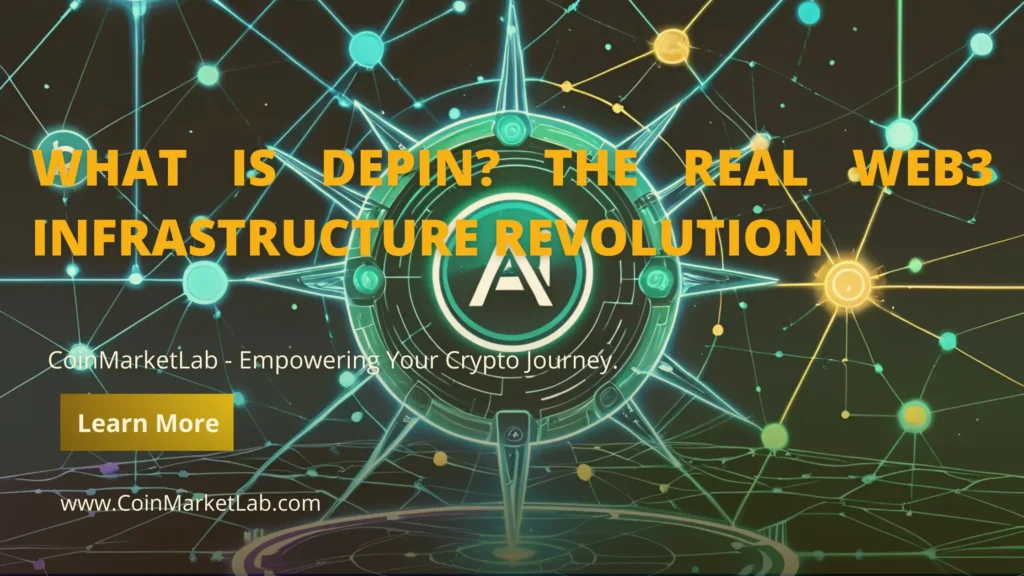
Web3 is moving beyond virtual wallets and on-chain tokens. The new frontier? Decentralized Physical Infrastructure Networks—better known as DePIN.
This emerging model allows anyone to build and own pieces of the real-world infrastructure that powers the digital economy: think wireless networks, compute power, storage, energy, and sensors—all coordinated on-chain.
Let’s break down what DePIN is, how it works, and why it’s one of the most disruptive crypto narratives of the decade.
🧠 What Is DePIN?
DePIN = Decentralized Physical Infrastructure Network
It’s a system where people contribute real-world resources (like bandwidth, compute, energy, sensors) and get rewarded in crypto.
Imagine Airbnb or Uber — but permissionless, tokenized, and fully decentralized.
🛠️ How It Works (Simple Flow)
- User provides infrastructure (e.g., hosts a 5G hotspot, GPU, or solar panel node)
- DePIN protocol measures contribution (via oracles, IoT, on-chain metrics)
- Token rewards are distributed based on actual usage or uptime
- Other users can access the service (e.g., compute, bandwidth, storage) via crypto payments
🔥 Top Real DePIN Projects (2025)
| Project | What It Does | Token |
|---|---|---|
| Helium (HNT) | Decentralized wireless 5G + IoT coverage | HNT |
| Render Network (RNDR) | Distributed GPU rendering for 3D, AI, video | RNDR |
| Akash Network (AKT) | Decentralized cloud computing (AWS alternative) | AKT |
| Filecoin (FIL) | Decentralized storage (Google Drive alternative) | FIL |
| HiveMapper (HONEY) | Maps the world using dashcam footage | HONEY |
| WeatherXM (WXM) | Decentralized weather data from community devices | WXM |
💡 Why DePIN Matters
- Ownership: No corporations—users own and profit from the infra they provide
- Permissionless Access: Anyone can use or contribute
- Incentivized Scaling: Rewards = faster adoption
- AI-Ready: Agents need infrastructure (compute, bandwidth), and DePIN supplies it
🧠 Use Case Example: AI x DePIN
Let’s say an AI agent needs to:
- Process data → Uses Render Network (GPU on demand)
- Store output → Uses Filecoin
- Send results to IoT devices → Uses Helium
The entire supply chain is decentralized, token-incentivized, and cost-effective.
📈 Why DePIN Is Exploding in 2025
- AI boom needs compute and bandwidth
- Tokenomics model rewards early participants
- Real-world data (weather, maps, connectivity) is in high demand
- People want to own the systems they use—not rent them from Big Tech
📦 DePIN Sectors in 2025
| Sector | Projects |
|---|---|
| Compute | Akash, Render, Gensyn, Bittensor |
| Storage | Filecoin, Arweave |
| Bandwidth | Helium, Nodle |
| Energy | DIMO, Plug Power (early models) |
| Data/Sensors | WeatherXM, HiveMapper, NATIX |
SEO Keywords to Include:
- What is DePIN crypto
- Top DePIN projects 2025
- Decentralized infrastructure networks
- Web3 real-world use cases
- Render vs Akash vs Filecoin
📌 FAQs
Q: Is DePIN just another buzzword?
A: No. DePIN is already being used to build decentralized versions of essential infrastructure. The projects are live and growing.
Q: How do I earn from DePIN projects?
A: By contributing hardware (e.g., hotspot, GPU node, weather device), and being rewarded with tokens.
Q: Can DePIN be profitable?
A: Yes, early adopters of networks like Helium and HiveMapper have earned substantial returns. Like mining, profitability depends on cost vs. demand.
✅ Conclusion
DePIN isn’t just another crypto narrative—it’s Web3 infrastructure with real-world impact. As AI, IoT, and the decentralized web grow, so does the need for globally distributed, tokenized infrastructure.
Want to be early again?
Join the DePIN revolution—and own the internet.
